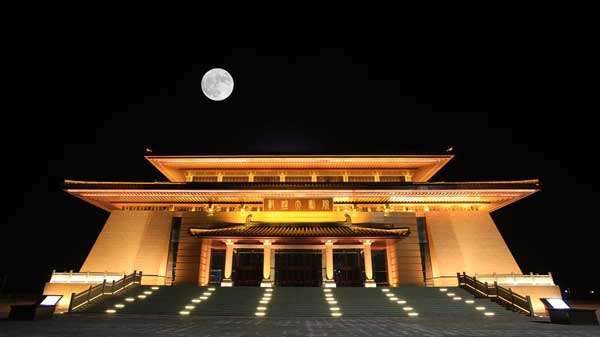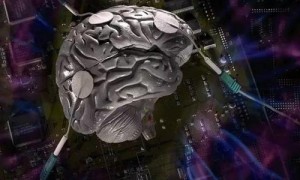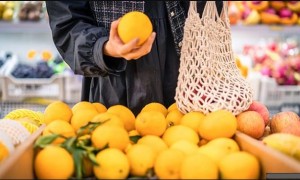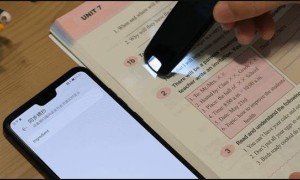自从“阿波罗11号飞船”开启了人类首次登月的太空征程之后,人类探月和在月球居住的梦想就一直没有停歇。据报道,中国希望在月球背面打造一个“微型生态圈”, 这有望使人类加快实现有朝一日在月球上居住的梦想。
 |
2016年11月14日,这是11月14日在甘肃敦煌拍摄的“超级月亮”(二次曝光)。新华社记者 辛悦卫 摄
|
China hopes to create a 'mini biosphere' on the dark side of the Moon, with flowers and silkworms sustaining each other as they grow on the lifeless lunar surface.
中国希望在月球背面打造一个“微型生态圈”,让花和蚕“相依为命”,在没有生命的月球表面生长。
The unprecedented plan to create life in outer space is the most intriguing part of China's lunar probe mission later this year, and could be a major boost for dreams that humans will one day live on the Moon.
这项史无前例的外太空生命培育计划是中国今年年底探月任务中最引人入胜的一部分,也将大力推进人类在月球居住梦想的实现。
The insects, plants, potato seeds and arabidopsis—a small flowering plant belonging to the mustard family - will be taken to the Moon on board the Chang'e-4 lander and rover in December.
昆虫、植物、马铃薯种子和拟南芥——一种属于十字花科的小型开花植物——将于今年12月搭乘嫦娥四号探测器前往月球。
They will be placed in an 18cm tall bucket-like tin made from special aluminum alloy materials, together with water, a nutrient solution, and a small camera and data transmission system.
它们将和水、营养液、微型照相机和信息传输系统一道,被放置在一个高18厘米由特殊铝合金材料制成的桶状罐子里。
A small tube will direct natural sunlight into the tin to help the plants and potato seeds grow. Although known figuratively as the "dark side" as it is unseen, the far side of the moon receives almost equal sunlight to the near side.
一个小导管会把自然光线导入罐子里,帮助这些植物和土豆种子生长。虽然人类看不见的月球背面被形象地称为“暗面”,但月球背面和正面所受到的太阳光照几乎是相等的。
The next stage of the mini-ecological system will see the plants emitting oxygen, which will feed the silkworms hatching from their cocoons.
在“微型生态圈”的下一个阶段中,植物会产生氧气,供蚕蛹孵化时使用。
The silkworms will create carbon dioxide and produce waste that will allow the plants to grow, Chinese scientists say.
中国科学家说,蚕会产生植物生长所需的二氧化碳和粪便。
"Our experiment might help accumulate knowledge for building a lunar base and long-term residence on the Moon," Professor Liu Hanlong, chief director of the experiment and vice president of Chongqing University, told Xinhua news agency.
担任实验项目总体负责人的重庆大学副校长刘汉龙教授对新华社记者说:“我们的实验将为人类在月球上建立基地和长期居住积累知识。”
Astronauts have previously grown plants in the International Space Station, while Chinese "taikonauts" grew rice and arabidopsis in China's Tiangong-2 space lab.
此前,航天员曾在国际空间站种过植物,而中国的航天员也曾在天宫二号空间实验室里培养过水稻和拟南芥。
But those experiments were conducted in low-Earth orbit at an altitude of about 400 kilometres.
但那些实验都是在离地面约400公里的近地轨道中进行的。
"The environment on the Moon, 380,000 kilometres from the Earth, is more complicated," Xinhua said.
新华社的报道称:“距离地球38万公里的月球环境要复杂得多。”
The moon's gravity is only about 16 percent of the earth's - which is considered a major barrier to the success of the project.
月球引力只相当于地球引力的16%左右,这被认为是该项目取得成功面临的主要障碍。
The development of living organisms would also be at risk from the harsh climate on the Moon, where temperatures range from lower than -100 °C to higher than 100 °C.
生物体的生长还将受到月球上恶劣气候的威胁,因为月球表面的温度既可以低于零下100摄氏度,也可以高于零上100摄氏度。
Xie Gengxin, chief designer of the experiment, said: "We have to keep the temperature in the 'mini biosphere' within a range from 1 degree to 30 degrees, and properly control the humidity and nutrition.
实验项目的总设计师谢更新说:“我们必须将‘微型生态圈’内的温度保持在1至30摄氏度之间,并控制好湿度和养分。”
"We will use a tube to direct the natural light on the surface of Moon into the tin to make the plants grow."
“我们将用一根导管把月球表面的自然光线导入罐子,以使植物生长。”
Potato and arabidopsis were chosen for the experiment because they grow quickly and can be easily observed by scientists.
选择马铃薯和拟南芥作为实验物种是因为它们的生长周期短且便于科学家观察。
"And potato could become a major source of food for future space travellers," said Professor Liu.
刘汉龙教授说:“同时,马铃薯还可作为未来空间旅行者的主要食物来源。”
China's plans to become the first country to softly land a probe to the dark side of the moon will represent the country's latest milestone in space.
中国计划成为第一个实现探测器在月球背面软着陆的国家。这将成为中国太空探索事业最新的里程碑。
In 2003, it became the third country to put a man in space with its own rocket after the former Soviet Union and the United States.
2003年,中国成为继苏联和美国之后第三个用自行研制的飞船将人送入太空的国家。
Ten years later it became the third country to carry out a lunar rover mission.
10年后,它又成为第三个实现月球探测器软着陆的国家。
China aims to land a man on the moon sometime after 2030, most observers say, while last year an official said that it would “not take long” before Beijing approved a manned lunar project.
大多数观察人士认为,中国计划在2030年后的某个时候实现载人登月,但去年一位官员说,载人登月计划获得中国政府批准的“时间不会太长”。







